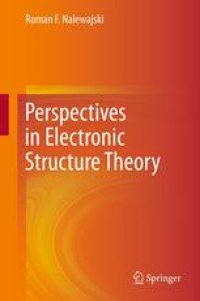
Ebook: Perspectives in Electronic Structure Theory
Author: Roman F. Nalewajski (auth.)
- Tags: Theoretical and Computational Chemistry, Solid State Physics, Quantum Physics, Atomic/Molecular Structure and Spectra, Quantum Information Technology Spintronics
- Year: 2012
- Publisher: Springer-Verlag Berlin Heidelberg
- Edition: 1
- Language: English
- pdf
The understanding in science implies insights from several different points of view. Alternative modern outlooks on electronic structure of atoms and molecules, all rooted in quantum mechanics, are presented in a single text. Together these complementary perspectives provide a deeper understanding of the localization of electrons and bonds, the origins of chemical interaction and reactivity behavior, the interaction between the geometric and electronic structure of molecules, etc. In the opening two parts the basic principles and techniques of the contemporary computational and conceptual quantum chemistry are presented, within both the wave-function and electron-density theories. This background material is followed by a discussion of chemical concepts, including stages of the bond-formation processes, chemical valence and bond-multiplicity indices, the hardness/softness descriptors of molecules and reactants, and general chemical reactivity/stability principles. The insights from Information Theory, the basic elements of which are briefly introduced, including the entropic origins and Orbital Communication Theory of the chemical bond, are the subject of Part IV. The importance of the non-additive (interference) information tools in exploring patterns of chemical bonds and their covalent and ionic components will be emphasized.
The understanding in science implies insights from several different points of view. Alternative modern outlooks on electronic structure of atoms and molecules, all rooted in quantum mechanics, are presented in a single text. Together these complementary perspectives provide a deeper understanding of the localization of electrons and bonds, the origins of chemical interaction and reactivity behavior, the interaction between the geometric and electronic structure of molecules, etc. In the opening two parts the basic principles and techniques of the contemporary computational and conceptual quantum chemistry are presented, within both the wave-function and electron-density theories. This background material is followed by a discussion of chemical concepts, including stages of the bond-formation processes, chemical valence and bond-multiplicity indices, the hardness/softness descriptors of molecules and reactants, and general chemical reactivity/stability principles. The insights from Information Theory, the basic elements of which are briefly introduced, including the entropic origins and Orbital Communication Theory of the chemical bond, are the subject of Part IV. The importance of the non-additive (interference) information tools in exploring patterns of chemical bonds and their covalent and ionic components will be emphasized.
The understanding in science implies insights from several different points of view. Alternative modern outlooks on electronic structure of atoms and molecules, all rooted in quantum mechanics, are presented in a single text. Together these complementary perspectives provide a deeper understanding of the localization of electrons and bonds, the origins of chemical interaction and reactivity behavior, the interaction between the geometric and electronic structure of molecules, etc. In the opening two parts the basic principles and techniques of the contemporary computational and conceptual quantum chemistry are presented, within both the wave-function and electron-density theories. This background material is followed by a discussion of chemical concepts, including stages of the bond-formation processes, chemical valence and bond-multiplicity indices, the hardness/softness descriptors of molecules and reactants, and general chemical reactivity/stability principles. The insights from Information Theory, the basic elements of which are briefly introduced, including the entropic origins and Orbital Communication Theory of the chemical bond, are the subject of Part IV. The importance of the non-additive (interference) information tools in exploring patterns of chemical bonds and their covalent and ionic components will be emphasized.
Content:
Front Matter....Pages i-xix
Front Matter....Pages 1-1
Sources....Pages 3-19
Mathematical Apparatus....Pages 21-50
Basic Concepts and Axioms....Pages 51-91
Hydrogen-Like Atom....Pages 93-109
Front Matter....Pages 111-111
Approximating Molecular Schr?dinger Equation....Pages 113-147
Wave Function Methods....Pages 149-254
Density Functional Theory....Pages 255-368
Front Matter....Pages 369-369
Elements of Information Theory....Pages 371-395
Schr?dinger Equations from Information Principles....Pages 397-414
Electron Density as Carrier of Information....Pages 415-452
Bonded Atoms from Information Theory....Pages 453-479
Orbital Communication Theory of the Chemical Bond....Pages 481-554
Front Matter....Pages 555-555
Alternative Perspectives in Chemical Theories....Pages 557-603
Coupling Between Electronic and Geometrical Structures....Pages 605-648
Qualitative Approaches to Reactivity Phenomena....Pages 649-674
Back Matter....Pages 675-718
The understanding in science implies insights from several different points of view. Alternative modern outlooks on electronic structure of atoms and molecules, all rooted in quantum mechanics, are presented in a single text. Together these complementary perspectives provide a deeper understanding of the localization of electrons and bonds, the origins of chemical interaction and reactivity behavior, the interaction between the geometric and electronic structure of molecules, etc. In the opening two parts the basic principles and techniques of the contemporary computational and conceptual quantum chemistry are presented, within both the wave-function and electron-density theories. This background material is followed by a discussion of chemical concepts, including stages of the bond-formation processes, chemical valence and bond-multiplicity indices, the hardness/softness descriptors of molecules and reactants, and general chemical reactivity/stability principles. The insights from Information Theory, the basic elements of which are briefly introduced, including the entropic origins and Orbital Communication Theory of the chemical bond, are the subject of Part IV. The importance of the non-additive (interference) information tools in exploring patterns of chemical bonds and their covalent and ionic components will be emphasized.
Content:
Front Matter....Pages i-xix
Front Matter....Pages 1-1
Sources....Pages 3-19
Mathematical Apparatus....Pages 21-50
Basic Concepts and Axioms....Pages 51-91
Hydrogen-Like Atom....Pages 93-109
Front Matter....Pages 111-111
Approximating Molecular Schr?dinger Equation....Pages 113-147
Wave Function Methods....Pages 149-254
Density Functional Theory....Pages 255-368
Front Matter....Pages 369-369
Elements of Information Theory....Pages 371-395
Schr?dinger Equations from Information Principles....Pages 397-414
Electron Density as Carrier of Information....Pages 415-452
Bonded Atoms from Information Theory....Pages 453-479
Orbital Communication Theory of the Chemical Bond....Pages 481-554
Front Matter....Pages 555-555
Alternative Perspectives in Chemical Theories....Pages 557-603
Coupling Between Electronic and Geometrical Structures....Pages 605-648
Qualitative Approaches to Reactivity Phenomena....Pages 649-674
Back Matter....Pages 675-718
....